2022 FORD BRONCO SPORT change wheel
[x] Cancel search: change wheelPage 10 of 494

Maintenance
General Information
..................................282
Opening and Closing the Hood .............
282
Under Hood Overview - 1.5L EcoBoost™ ........................................................................\
283
Under Hood Overview - 2.0L EcoBoost™ ........................................................................\
284
Engine Oil Dipstick - 1.5L EcoBoost™ ........................................................................\
285
Engine Oil Dipstick - 2.0L EcoBoost™ ........................................................................\
285
Engine Oil Check .........................................
285
Oil Change Indicator Reset .....................
286
Changing the Engine Air Filter ...............
286
Engine Coolant Check ...............................
287
Automatic Transmission Fluid Check ........................................................................\
.
291
Brake Fluid Check .......................................
292
Power Steering Fluid Check ....................
293
Changing the 12V Battery ........................
293
Adjusting the Headlamps .......................
295
Washer Fluid Check ...................................
296
Fuel Filter .......................................................
296
Checking the Wiper Blades .....................
297
Changing the Front Wiper Blades ........
297
Changing the Rear Wiper Blades ..........
297
Changing a Bulb .........................................
298
Vehicle Care
General Information .................................
300
Cleaning Products .....................................
300
Cleaning the Exterior ..................................
301
Waxing ............................................................
302
Cleaning the Engine ...................................
302
Cleaning the Windows and Wiper Blades ........................................................................\
303
Cleaning the Interior ..................................
303
Cleaning the Instrument Panel and Instrument Cluster Lens ......................
304
Repairing Minor Paint Damage .............
305
Cleaning the Wheels .................................
305Vehicle Storage
...........................................
305
Wheels and Tires
General Information ..................................
308
Tire Care ..........................................................
310
Using Snow Chains ....................................
323
Tire Pressure Monitoring System ..........
324
Changing a Road Wheel ..........................
329
Technical Specifications ..........................
335
Capacities and Specifications
Engine Specifications - 1.5L EcoBoost™ ........................................................................\
336
Engine Specifications - 2.0L EcoBoost™ ........................................................................\
336
Motorcraft Parts - 1.5L EcoBoost™ ......
337
Motorcraft Parts - 2.0L EcoBoost™ .....
338
Bulb Specification Chart .........................
338
Engine Oil Capacity and Specification - 2.0L EcoBoost™ ....................................
340
Engine Oil Capacity and Specification - 1.5L EcoBoost™ .......................................
341
Cooling System Capacity and Specification - 2.0L EcoBoost™ ......
343
Cooling System Capacity and Specification - 1.5L EcoBoost™ .......
344
Fuel Tank Capacity ....................................
344
Air Conditioning System Capacity and Specification - 2.0L EcoBoost™ ......
345
Air Conditioning System Capacity and Specification - 1.5L EcoBoost™ .......
346
Washer Fluid Specification .....................
346
Brake Fluid Specification .........................
347
Vehicle Identification
Vehicle Identification Number ..............
348
Connected Vehicle
What Is a Connected Vehicle .................
349
Connected Vehicle Requirements .......
349
7
2022 Bronco Sport (CHD) Canada/United States of America, enUSA, Edition date: 202107, First-Printing Table of Contents
Page 114 of 494
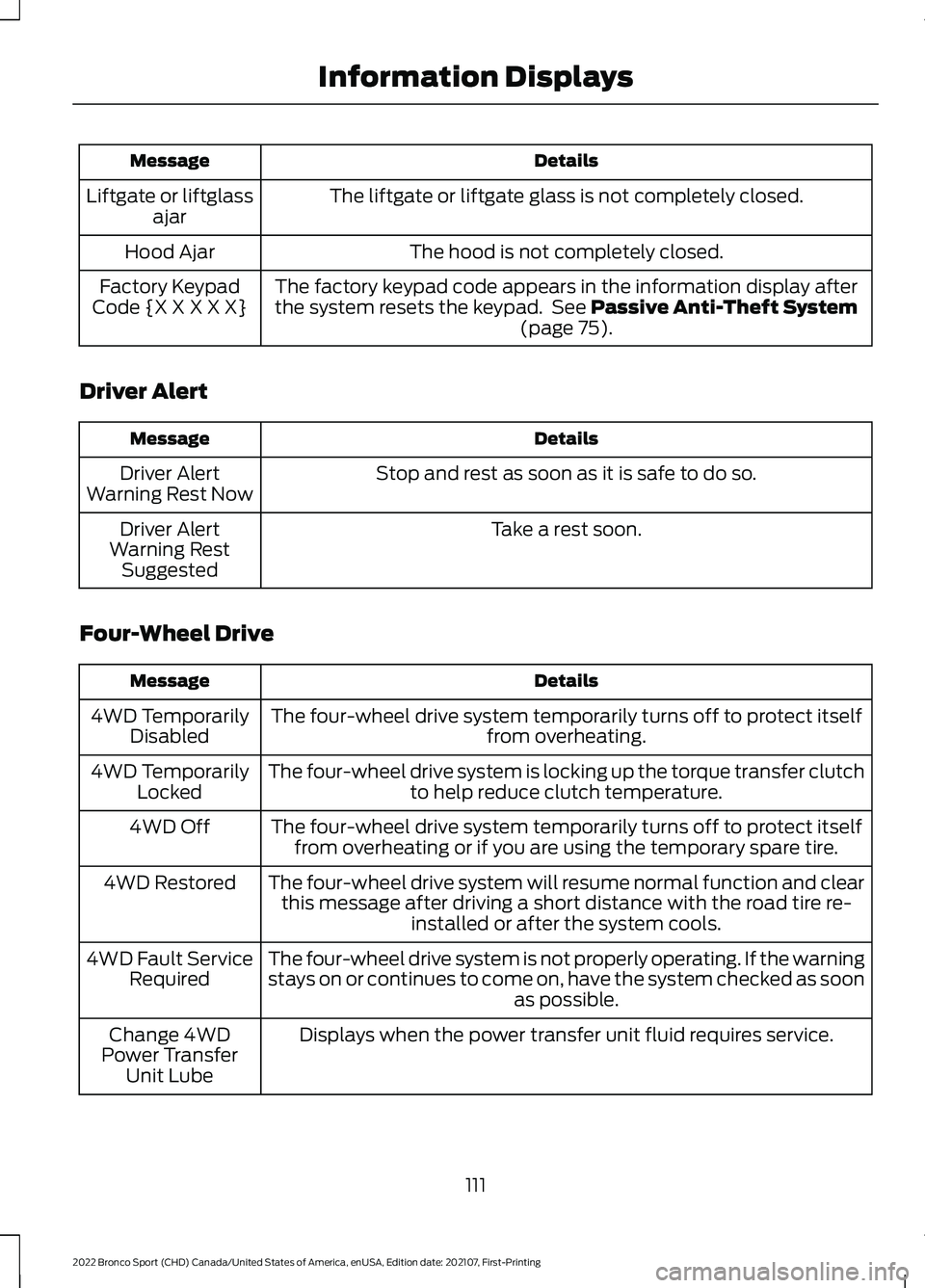
Details
Message
The liftgate or liftgate glass is not completely closed.
Liftgate or liftglass
ajar
The hood is not completely closed.
Hood Ajar
The factory keypad code appears in the information display after
the system resets the keypad. See Passive Anti-Theft System
(page 75).
Factory Keypad
Code {X X X X X}
Driver Alert Details
Message
Stop and rest as soon as it is safe to do so.
Driver Alert
Warning Rest Now
Take a rest soon.
Driver Alert
Warning Rest Suggested
Four-Wheel Drive Details
Message
The four-wheel drive system temporarily turns off to protect itself from overheating.
4WD Temporarily
Disabled
The four-wheel drive system is locking up the torque transfer clutch to help reduce clutch temperature.
4WD Temporarily
Locked
The four-wheel drive system temporarily turns off to protect itselffrom overheating or if you are using the temporary spare tire.
4WD Off
The four-wheel drive system will resume normal function and clearthis message after driving a short distance with the road tire re- installed or after the system cools.
4WD Restored
The four-wheel drive system is not properly operating. If the warning
stays on or continues to come on, have the system checked as soon as possible.
4WD Fault Service
Required
Displays when the power transfer unit fluid requires service.
Change 4WD
Power Transfer Unit Lube
111
2022 Bronco Sport (CHD) Canada/United States of America, enUSA, Edition date: 202107, First-Printing Information Displays
Page 115 of 494

Details
Message
Displays when you have the power transfer unit fluid changed and reset to new.
4WD Power
Transfer Unit Lube Set to New
The selected drive mode does not allow you to turn on the rear differential lock feature.
Rear Differential
Lock Not Available in Current Drive Mode
The selected drive mode requires your vehicle to be in four-wheel drive.
4WD Lock
Required in Current Drive Mode
Fuel Details
Message
An early reminder of a low fuel condition.
Fuel Level Low
The fuel fill inlet may not be properly closed.
Check Fuel Fill
Inlet
Wait for up to 15 seconds while the fuel system depressurizes.
Fuel Door Opening
The fuel system has finished depressurizing and you can begin to
refuel.
Fuel Door Open
A reminder to close the fuel door. Failure to follow this instruction
can cause the check engine light to illuminate.
Close Fuel Door to
Avoid ""CheckEngine"" Light
There is an error in attempting to refill your vehicle.
Refuel Error See
Manual
Hill Start Assist Details
Message
Hill start assist is not available. Have the system checked as soonas possible. See Hill Start Assist (page 184).
Hill Start Assist
Not Available
112
2022 Bronco Sport (CHD) Canada/United States of America, enUSA, Edition date: 202107, First-Printing Information Displays
Page 117 of 494
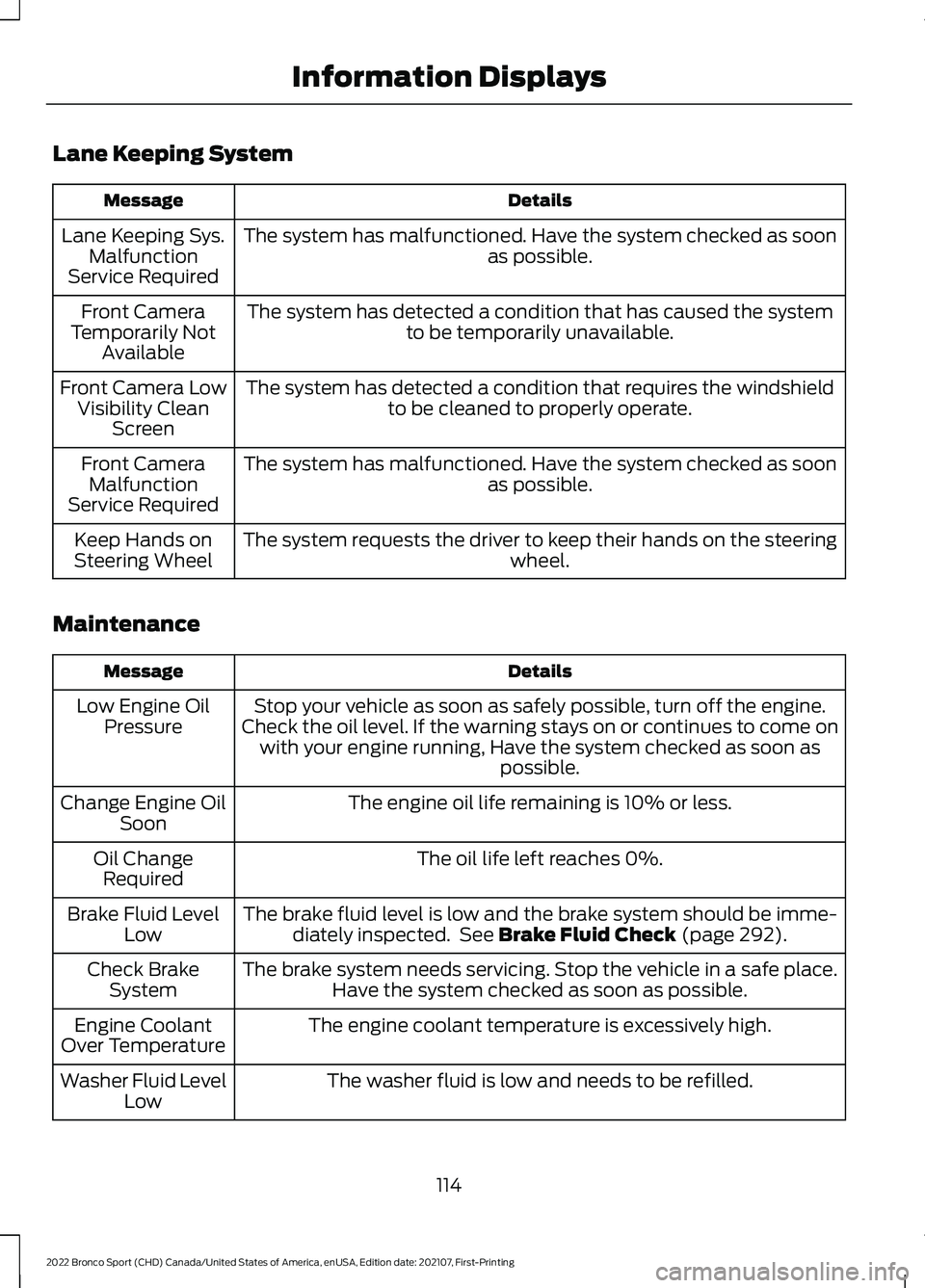
Lane Keeping System
Details
Message
The system has malfunctioned. Have the system checked as soon as possible.
Lane Keeping Sys.
Malfunction
Service Required
The system has detected a condition that has caused the systemto be temporarily unavailable.
Front Camera
Temporarily Not Available
The system has detected a condition that requires the windshieldto be cleaned to properly operate.
Front Camera Low
Visibility Clean Screen
The system has malfunctioned. Have the system checked as soon as possible.
Front Camera
Malfunction
Service Required
The system requests the driver to keep their hands on the steering wheel.
Keep Hands on
Steering Wheel
Maintenance Details
Message
Stop your vehicle as soon as safely possible, turn off the engine.
Check the oil level. If the warning stays on or continues to come on with your engine running, Have the system checked as soon as possible.
Low Engine Oil
Pressure
The engine oil life remaining is 10% or less.
Change Engine Oil
Soon
The oil life left reaches 0%.
Oil Change
Required
The brake fluid level is low and the brake system should be imme-diately inspected. See Brake Fluid Check (page 292).
Brake Fluid Level
Low
The brake system needs servicing. Stop the vehicle in a safe place.Have the system checked as soon as possible.
Check Brake
System
The engine coolant temperature is excessively high.
Engine Coolant
Over Temperature
The washer fluid is low and needs to be refilled.
Washer Fluid Level
Low
114
2022 Bronco Sport (CHD) Canada/United States of America, enUSA, Edition date: 202107, First-Printing Information Displays
Page 182 of 494
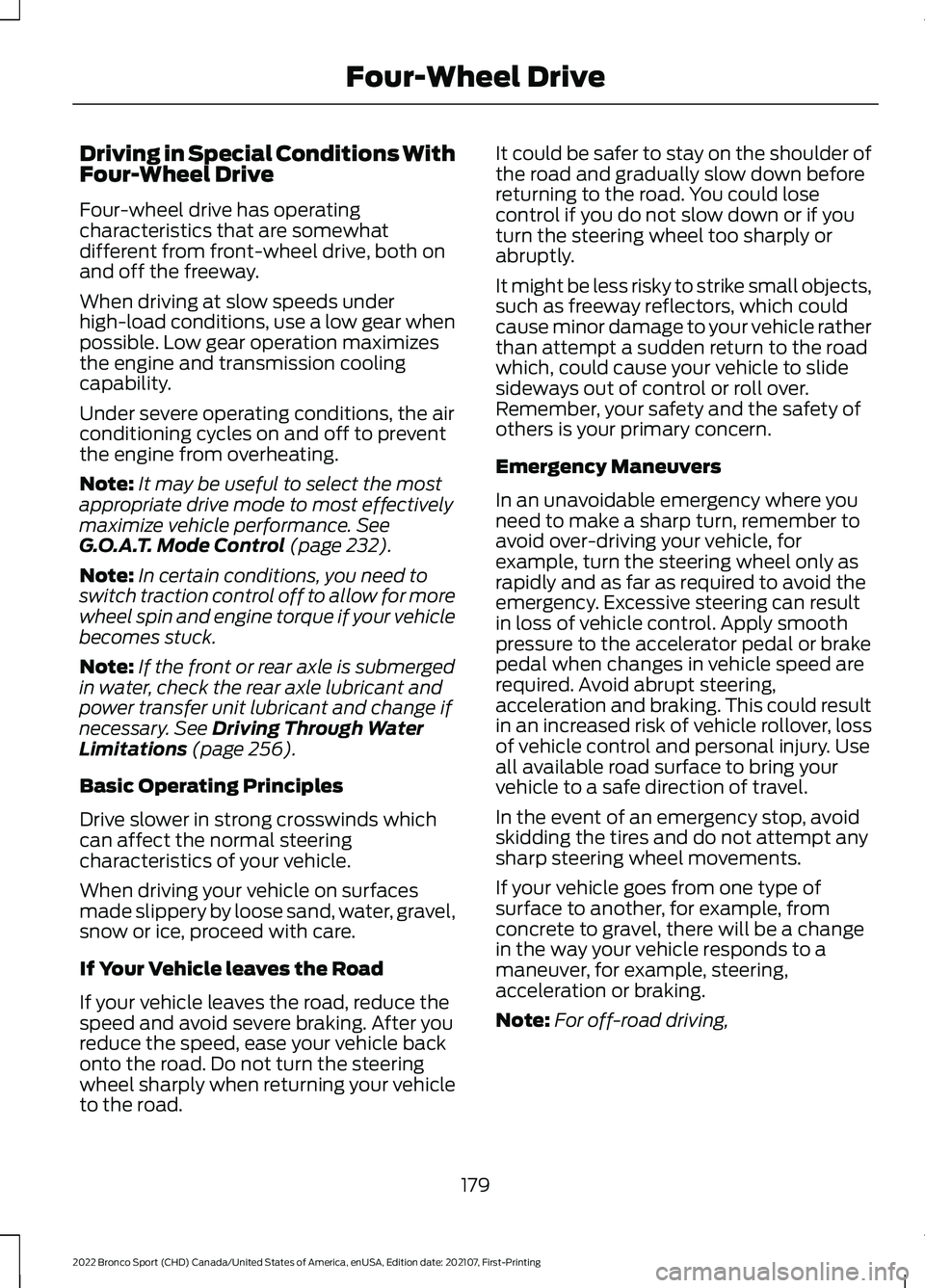
Driving in Special Conditions With
Four-Wheel Drive
Four-wheel drive has operating
characteristics that are somewhat
different from front-wheel drive, both on
and off the freeway.
When driving at slow speeds under
high-load conditions, use a low gear when
possible. Low gear operation maximizes
the engine and transmission cooling
capability.
Under severe operating conditions, the air
conditioning cycles on and off to prevent
the engine from overheating.
Note:
It may be useful to select the most
appropriate drive mode to most effectively
maximize vehicle performance. See
G.O.A.T. Mode Control (page 232).
Note: In certain conditions, you need to
switch traction control off to allow for more
wheel spin and engine torque if your vehicle
becomes stuck.
Note: If the front or rear axle is submerged
in water, check the rear axle lubricant and
power transfer unit lubricant and change if
necessary.
See Driving Through Water
Limitations (page 256).
Basic Operating Principles
Drive slower in strong crosswinds which
can affect the normal steering
characteristics of your vehicle.
When driving your vehicle on surfaces
made slippery by loose sand, water, gravel,
snow or ice, proceed with care.
If Your Vehicle leaves the Road
If your vehicle leaves the road, reduce the
speed and avoid severe braking. After you
reduce the speed, ease your vehicle back
onto the road. Do not turn the steering
wheel sharply when returning your vehicle
to the road. It could be safer to stay on the shoulder of
the road and gradually slow down before
returning to the road. You could lose
control if you do not slow down or if you
turn the steering wheel too sharply or
abruptly.
It might be less risky to strike small objects,
such as freeway reflectors, which could
cause minor damage to your vehicle rather
than attempt a sudden return to the road
which, could cause your vehicle to slide
sideways out of control or roll over.
Remember, your safety and the safety of
others is your primary concern.
Emergency Maneuvers
In an unavoidable emergency where you
need to make a sharp turn, remember to
avoid over-driving your vehicle, for
example, turn the steering wheel only as
rapidly and as far as required to avoid the
emergency. Excessive steering can result
in loss of vehicle control. Apply smooth
pressure to the accelerator pedal or brake
pedal when changes in vehicle speed are
required. Avoid abrupt steering,
acceleration and braking. This could result
in an increased risk of vehicle rollover, loss
of vehicle control and personal injury. Use
all available road surface to bring your
vehicle to a safe direction of travel.
In the event of an emergency stop, avoid
skidding the tires and do not attempt any
sharp steering wheel movements.
If your vehicle goes from one type of
surface to another, for example, from
concrete to gravel, there will be a change
in the way your vehicle responds to a
maneuver, for example, steering,
acceleration or braking.
Note:
For off-road driving,
179
2022 Bronco Sport (CHD) Canada/United States of America, enUSA, Edition date: 202107, First-Printing Four-Wheel Drive
Page 183 of 494
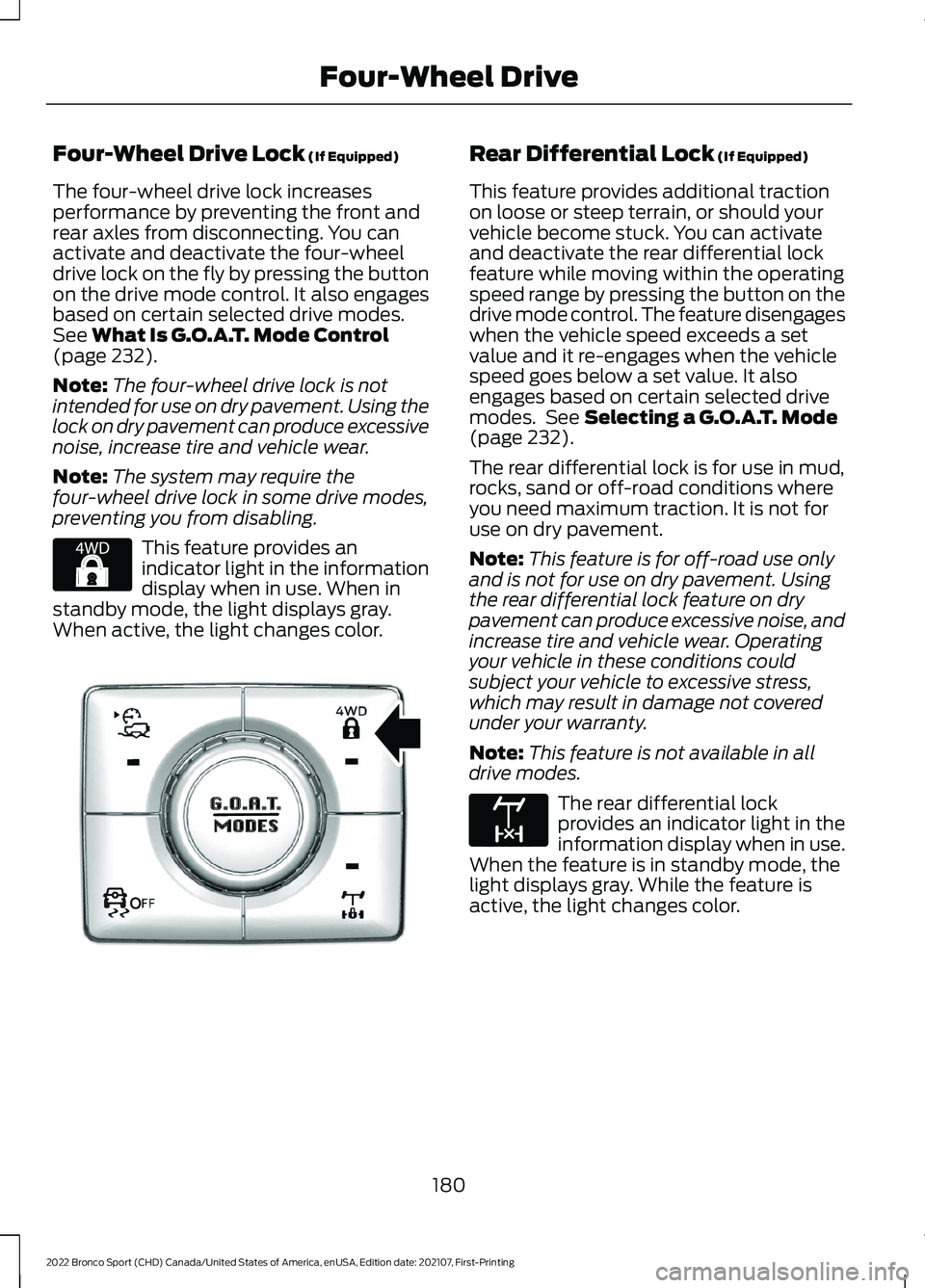
Four-Wheel Drive Lock (If Equipped)
The four-wheel drive lock increases
performance by preventing the front and
rear axles from disconnecting. You can
activate and deactivate the four-wheel
drive lock on the fly by pressing the button
on the drive mode control. It also engages
based on certain selected drive modes.
See
What Is G.O.A.T. Mode Control
(page 232).
Note: The four-wheel drive lock is not
intended for use on dry pavement. Using the
lock on dry pavement can produce excessive
noise, increase tire and vehicle wear.
Note: The system may require the
four-wheel drive lock in some drive modes,
preventing you from disabling. This feature provides an
indicator light in the information
display when in use. When in
standby mode, the light displays gray.
When active, the light changes color. Rear Differential Lock
(If Equipped)
This feature provides additional traction
on loose or steep terrain, or should your
vehicle become stuck. You can activate
and deactivate the rear differential lock
feature while moving within the operating
speed range by pressing the button on the
drive mode control. The feature disengages
when the vehicle speed exceeds a set
value and it re-engages when the vehicle
speed goes below a set value. It also
engages based on certain selected drive
modes. See
Selecting a G.O.A.T. Mode
(page 232).
The rear differential lock is for use in mud,
rocks, sand or off-road conditions where
you need maximum traction. It is not for
use on dry pavement.
Note: This feature is for off-road use only
and is not for use on dry pavement. Using
the rear differential lock feature on dry
pavement can produce excessive noise, and
increase tire and vehicle wear. Operating
your vehicle in these conditions could
subject your vehicle to excessive stress,
which may result in damage not covered
under your warranty.
Note: This feature is not available in all
drive modes. The rear differential lock
provides an indicator light in the
information display when in use.
When the feature is in standby mode, the
light displays gray. While the feature is
active, the light changes color.
180
2022 Bronco Sport (CHD) Canada/United States of America, enUSA, Edition date: 202107, First-Printing Four-Wheel DriveE327288 O OE351064 E163170
Page 191 of 494
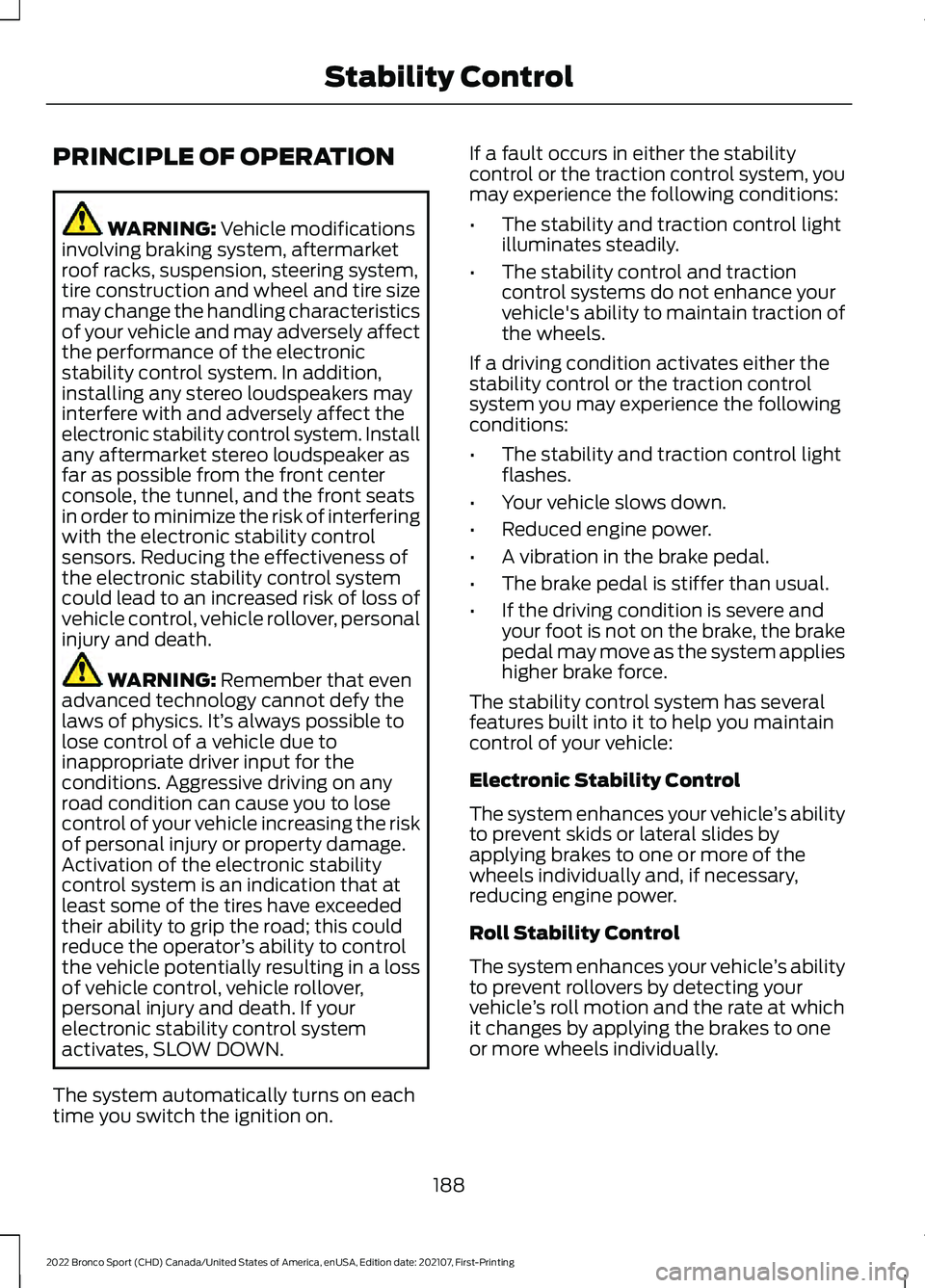
PRINCIPLE OF OPERATION
WARNING: Vehicle modifications
involving braking system, aftermarket
roof racks, suspension, steering system,
tire construction and wheel and tire size
may change the handling characteristics
of your vehicle and may adversely affect
the performance of the electronic
stability control system. In addition,
installing any stereo loudspeakers may
interfere with and adversely affect the
electronic stability control system. Install
any aftermarket stereo loudspeaker as
far as possible from the front center
console, the tunnel, and the front seats
in order to minimize the risk of interfering
with the electronic stability control
sensors. Reducing the effectiveness of
the electronic stability control system
could lead to an increased risk of loss of
vehicle control, vehicle rollover, personal
injury and death. WARNING:
Remember that even
advanced technology cannot defy the
laws of physics. It’ s always possible to
lose control of a vehicle due to
inappropriate driver input for the
conditions. Aggressive driving on any
road condition can cause you to lose
control of your vehicle increasing the risk
of personal injury or property damage.
Activation of the electronic stability
control system is an indication that at
least some of the tires have exceeded
their ability to grip the road; this could
reduce the operator ’s ability to control
the vehicle potentially resulting in a loss
of vehicle control, vehicle rollover,
personal injury and death. If your
electronic stability control system
activates, SLOW DOWN.
The system automatically turns on each
time you switch the ignition on. If a fault occurs in either the stability
control or the traction control system, you
may experience the following conditions:
•
The stability and traction control light
illuminates steadily.
• The stability control and traction
control systems do not enhance your
vehicle's ability to maintain traction of
the wheels.
If a driving condition activates either the
stability control or the traction control
system you may experience the following
conditions:
• The stability and traction control light
flashes.
• Your vehicle slows down.
• Reduced engine power.
• A vibration in the brake pedal.
• The brake pedal is stiffer than usual.
• If the driving condition is severe and
your foot is not on the brake, the brake
pedal may move as the system applies
higher brake force.
The stability control system has several
features built into it to help you maintain
control of your vehicle:
Electronic Stability Control
The system enhances your vehicle ’s ability
to prevent skids or lateral slides by
applying brakes to one or more of the
wheels individually and, if necessary,
reducing engine power.
Roll Stability Control
The system enhances your vehicle ’s ability
to prevent rollovers by detecting your
vehicle ’s roll motion and the rate at which
it changes by applying the brakes to one
or more wheels individually.
188
2022 Bronco Sport (CHD) Canada/United States of America, enUSA, Edition date: 202107, First-Printing Stability Control
Page 193 of 494
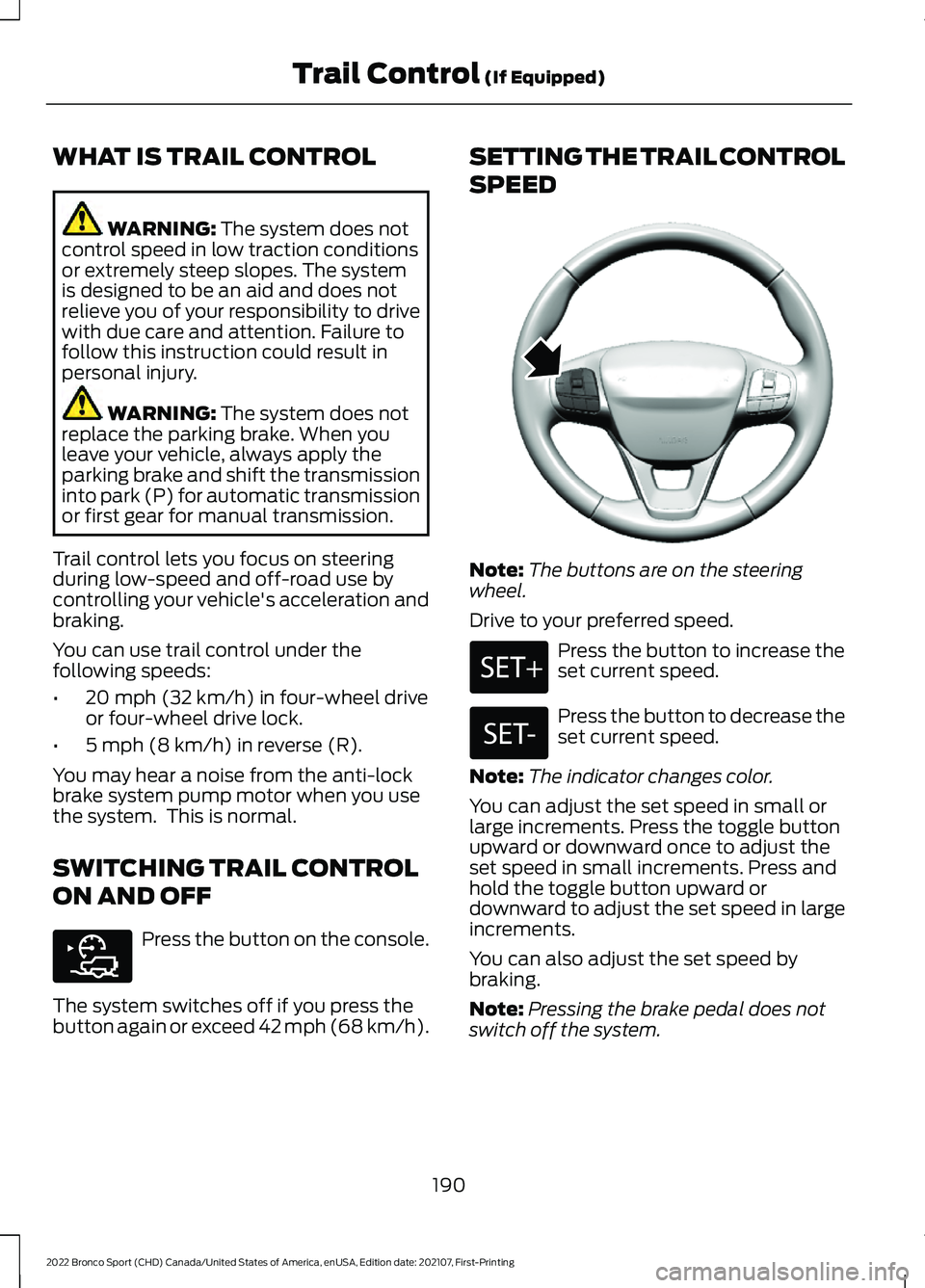
WHAT IS TRAIL CONTROL
WARNING: The system does not
control speed in low traction conditions
or extremely steep slopes. The system
is designed to be an aid and does not
relieve you of your responsibility to drive
with due care and attention. Failure to
follow this instruction could result in
personal injury. WARNING:
The system does not
replace the parking brake. When you
leave your vehicle, always apply the
parking brake and shift the transmission
into park (P) for automatic transmission
or first gear for manual transmission.
Trail control lets you focus on steering
during low-speed and off-road use by
controlling your vehicle's acceleration and
braking.
You can use trail control under the
following speeds:
• 20 mph (32 km/h)
in four-wheel drive
or four-wheel drive lock.
• 5 mph (8 km/h)
in reverse (R).
You may hear a noise from the anti-lock
brake system pump motor when you use
the system. This is normal.
SWITCHING TRAIL CONTROL
ON AND OFF Press the button on the console.
The system switches off if you press the
button again or exceed 42 mph (68 km/h). SETTING THE TRAIL CONTROL
SPEED
Note:
The buttons are on the steering
wheel.
Drive to your preferred speed. Press the button to increase the
set current speed.
Press the button to decrease the
set current speed.
Note: The indicator changes color.
You can adjust the set speed in small or
large increments. Press the toggle button
upward or downward once to adjust the
set speed in small increments. Press and
hold the toggle button upward or
downward to adjust the set speed in large
increments.
You can also adjust the set speed by
braking.
Note: Pressing the brake pedal does not
switch off the system.
190
2022 Bronco Sport (CHD) Canada/United States of America, enUSA, Edition date: 202107, First-Printing Trail Control
(If Equipped)E318506 E318924